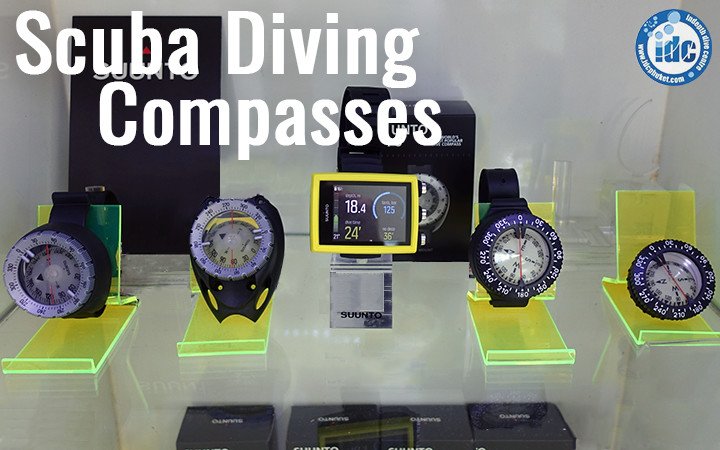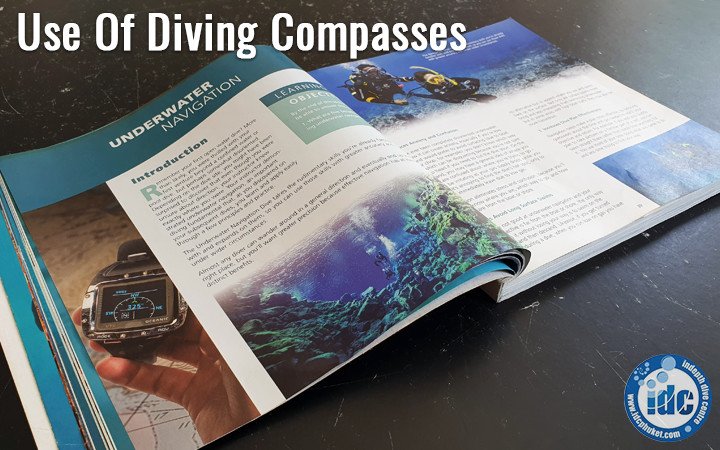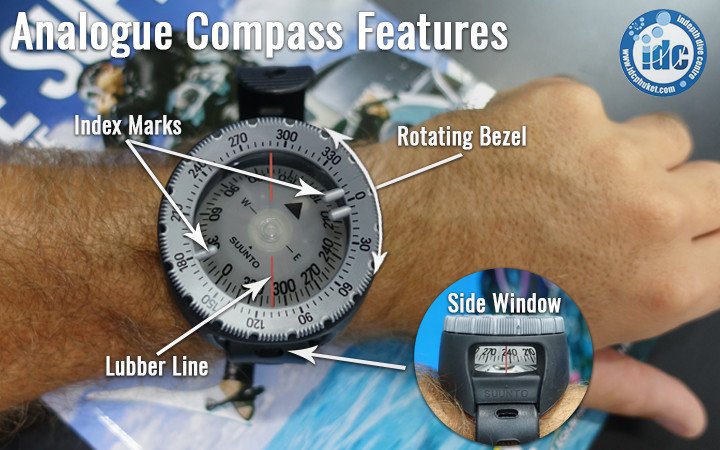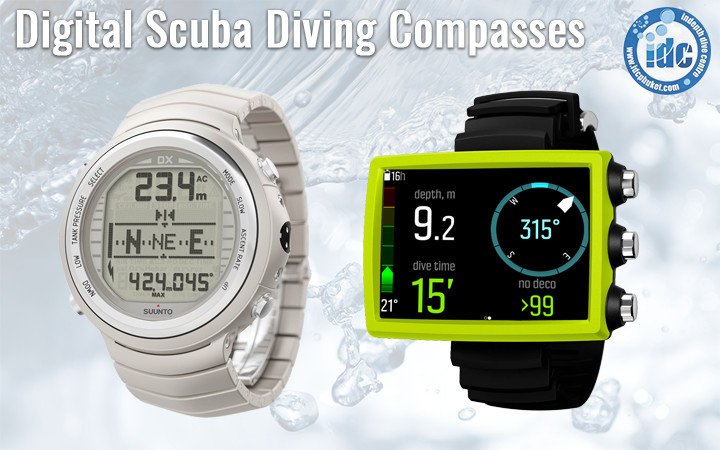Scuba Diving Compasses
Why should divers carry a scuba compass? Navigating underwater is a vital skill for all scuba divers, for this reason, navigation is a core skill taught on the Open Water Diver Course. Underwater navigation is more difficult than it sounds, even the most experienced diver can struggle with their sense of direction. Even more so when you factor in things like poor visibility and ocean currents. It can be easy to lose orientation underwater. Without the ability to effectively navigate underwater, divers may be unable to return to their planned exit point. They may even surface in the wrong place making it more difficult for boat crews to locate them.
Being lost underwater is also worrying. It often means you miss out on the key attractions of the dive site. Your focus is taken away from the enjoyment of the dive and redirected towards trying to find your way. Getting lost also often increases the diver’s stress levels and breathing rate meaning their gas supply doesn’t last as long. Not to mention, it’s embarrassing when other divers are following you and you don’t know where you are going.
The Use of Diving Compasses
Although not a mandatory piece of equipment for divers, we highly recommend all divers carry with them some form of compass on each dive. For some divers, particularly if it has been a while since your Open Water Course, you might wish to refresh or improve your underwater navigation skills and can do so by taking either your Advanced Open Water Diver Course which includes a mandatory underwater navigation dive where you will learn some new compass skills as well as learn how to measure distances underwater or alternatively, take your Underwater Navigation Specialty Course. In the course, you don’t only learn more advanced compass skills such as measuring distances underwater. You will also combine natural references with compass bearings improving your overall situational awareness and confidence navigating the dive site.
In this blog we’ll look at the two main types of scuba compasses used by divers; the analogue compass and the digital compass. As always, this is not exhaustive so if you have any questions about a piece of equipment you are using or thinking about buying, you can contact us here and we’ll be happy to provide you with some advice.
With any compass you purchase or use, the most important consideration is that it’s easy to read, operate and understand. Whether it is analogue or digital, we recommend you practice with your compass on land before diving with it. Compasses work by using the magnetic field of the Earth to locate and track the magnetic north (learn more here). Despite their simplicity, it’s still important divers know how to set reciprocal headings on their scuba compass as well as setting bearings in the direction of their exit, their boat or a landmark so they can maintain a sense of direction underwater.
Analogue Scuba Compasses
Features
The simplest form of scuba compass and the one which you would have learnt to use on your Open Water Course is the analogue compass. This compass consists of a clear, round, plastic or Perspex window with which to view the compass needle and a lubber line engraved or printed onto the window which indicates your direction of travel. The area encompassing the compass needle is liquid filled, allowing the compass needles the ability to move freely. Around the outside of the compass is a circular bezel which rotates. The bezel features index markers directly opposite one another, which you use to mark your compass heading.
Some compasses have a window on their side so the user can view the bearings from either above or from the side. On the bezel, there are a series of numbers printed or engraved into it which indicate how many degrees you are heading. North is indicated by 0°.
Pros and Cons of Analogue Compasses
Before the growth in affordable dive computers and digital compasses, analogue compasses were popular, simply because there were few alternatives. Analogue compasses have both advantages and disadvantages. One advantage is that they are relatively inexpensive and easy to use. They can be used both during the day as well as at night. Users can illuminate them by holding a light to their face momentarily, after which they temporarily glow in the dark.
A disadvantage of them is that when you are using them, you need to hold them flat. If not, the compass is unable to spin freely and can give false readings or become stuck. You learn on your Open Water Course the correct arm position to adopt when navigating with an analogue compass in order to prevent this issue. Another downside is if the viewing window becomes shattered or cracked, the fluid can leak out from it. Obviously, this will render the compass no longer useable.
Analogue Compasses – Different Mounts & Clipping Options
Wrist-mounted Compasses
 Analogue scuba compasses can attach to the diver as a wrist-mounted accessory, like a watch or computer. Some models include wrist bands and fasten up like a watch would. Others include bungee straps which fit and tighten around the diver’s arm and are easy to adjust. If you are going to wear a wrist-mounted compass, you should wear it on the same side as your computer. This way you can still monitor your depth, time and no decompression limit whilst using the compass.
Analogue scuba compasses can attach to the diver as a wrist-mounted accessory, like a watch or computer. Some models include wrist bands and fasten up like a watch would. Others include bungee straps which fit and tighten around the diver’s arm and are easy to adjust. If you are going to wear a wrist-mounted compass, you should wear it on the same side as your computer. This way you can still monitor your depth, time and no decompression limit whilst using the compass.
Console-integrated Compasses
 Another option for mounting a scuba compass is on your console, just above your submersible pressure gauge. Alternatively, sometimes, on the rear of an analogue depth gauge. The advantage is that you don’t have to remember to carry it as it is always attached to your equipment. At the same time, being attached to a hose makes it harder to bring up in front of you and hold in a correct position whilst swimming.
Another option for mounting a scuba compass is on your console, just above your submersible pressure gauge. Alternatively, sometimes, on the rear of an analogue depth gauge. The advantage is that you don’t have to remember to carry it as it is always attached to your equipment. At the same time, being attached to a hose makes it harder to bring up in front of you and hold in a correct position whilst swimming.
BCD Clipping Options
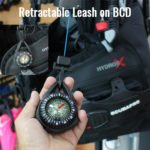 Other divers choose to clip the compass to one of their buoyancy control device’s D-rings with a retractable leash so when they are not using it, it is not in the way but when they do want to use it, they can extend it out in front of them and hold it in a comfortable position which is easy to view. A downside of this option is that over time the leash can wear and break which means if this happens underwater, a lost compass.
Other divers choose to clip the compass to one of their buoyancy control device’s D-rings with a retractable leash so when they are not using it, it is not in the way but when they do want to use it, they can extend it out in front of them and hold it in a comfortable position which is easy to view. A downside of this option is that over time the leash can wear and break which means if this happens underwater, a lost compass.
Mini Compasses
 A further option for carrying an analogue compass is to use a very small one. Often without a rotating bezel, it will fit around your dive computer’s watch strap. In order for the diver to use it, they simply tilt their wrist to view the compass. A downside of this model is that because there is no bezel on some models, it is difficult to set compass bearings. Also because of the small size of the compass, it can be difficult to read. As a positive thought, being so compact it can permanently live on the computer strap so you don’t forget it. They are usually a great option to carry as a backup.
A further option for carrying an analogue compass is to use a very small one. Often without a rotating bezel, it will fit around your dive computer’s watch strap. In order for the diver to use it, they simply tilt their wrist to view the compass. A downside of this model is that because there is no bezel on some models, it is difficult to set compass bearings. Also because of the small size of the compass, it can be difficult to read. As a positive thought, being so compact it can permanently live on the computer strap so you don’t forget it. They are usually a great option to carry as a backup.
Digital Scuba Compasses
Features
With advancements in technology these days, more and more diving computers are also coming with a built-in digital compass. Computers and their compasses vary though. As such, it’s essential to read the manufacturer’s literature and familiarise yourself with the functions, settings and operating the computer. Most digital compasses will allow you to set reciprocal headings and take bearings. On some computer models though, the compass mode appears through a separate menu. This means that when viewing the compass, the diver cannot view their depth, time or no-deco limit. They must switch between two menus in order to monitor both. On other computer models, the compass when activated appears on the main screen alongside the other diving information. This allows the diver to keep everything under control at a glance.
Pros and Cons of Digital Compasses
An advantage of a digital compass is that you don’t have to turn any bezels to set a compass bearing. You don’t even need to hold the device flat. A digital compass is usually very easy to operate. Users can set a bearing with the push of a button and the compass works in any position. Some models will even tell you which way to turn and by how much in order to return to your set heading if you head off course. A disadvantage of a digital compass is that it relies on your computer having sufficient battery for the whole dive. Many digital compasses also need to be regularly calibrated to ensure accuracy. Some models of computer will prompt you to do this when you change batteries.
Conclusions
Although not a mandatory piece of equipment, for your own comfort and safety, we highly recommend you carry a compass with you on your dives and practice using it. If you would like any advice regarding scuba compasses, or if you would like to discuss what courses you can take to develop and improve your underwater navigation skills, we are happy to help and you can send us a message here.
More posts about diving equipment:
- Choosing Dive Equipment
- Choosing a Scuba Diving Mask
- All about snorkels
- Choosing the right fins
- Scuba Cylinders & Valves
- Buoyancy Control Devices (BCDs)
- How to choose a Scuba Regulator
- Breathing Gas Monitoring Devices
- Depth Monitoring Devices
- Scuba Diving Weights and Quick Release Weight Systems
- Choosing a wetsuit for Scuba Diving
- Audible Signaling Devices for Scuba Diving



